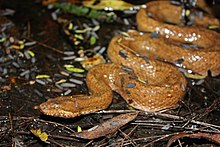Tropidophis melanurus
| Tropidophis melanurus | |
|---|---|

| |

| |
| Scientific classification | |
| Kingdom: | Animalia |
| Phylum: | Chordata |
| Class: | Reptilia |
| Order: | Squamata |
| Suborder: | Serpentes |
| Family: | Tropidophiidae |
| Genus: | Tropidophis |
| Species: | T. melanurus
|
| Binomial name | |
| Tropidophis melanurus (Schlegel, 1837)
| |
| Synonyms | |
| |
Tropidophis melanurus, commonly known as dusky dwarf boa,[2] Cuban wood snake, or Cuban giant dwarf boa, is a non-venomous dwarf boa species found mainly in Cuba. Currently, there are three subspecies recognized, including the typical form described here.[2]
Description[]
Adults grow to an average of 32 to 39 in (80 to 100 cm) in length.[3]
Geographic range[]
Found in Cuba, as well as on some nearby islands, including Cayos de San Felipe (Cayo Real), Isla de la Juventud and Navassa Island. The type locality given is "l'île de Cuba."[1]
Feeding[]
Under natural circumstances, the diet consists of lizards and amphibians, although specimens in captivity can be switched to rodents.
Subspecies[]
| Subspecies[2] | Taxon author[2] | Common name | Geographic range |
|---|---|---|---|
| Schwartz & Thomas, 1960 | Type locality: "one km N. of La Coloma, Pinar del Río Province, Cuba. | ||
| Schwartz & Thomas, 1960 | Type locality: "Bibijagua, Isla de Piños, Habana Province, Cuba." | ||
| Tropidophis melanurus melanurus | (Schlegel, 1837) | Type locality: "l'île de Cuba." |
References[]
- ^ a b McDiarmid RW, Campbell JA, Touré T. 1999. Snake Species of the World: A Taxonomic and Geographic Reference, vol. 1. Herpetologists' League. 511 pp. ISBN 1-893777-00-6 (series). ISBN 1-893777-01-4 (volume).
- ^ a b c d "Tropidophis melanurus". Integrated Taxonomic Information System. Retrieved 25 September 2007.
- ^ Burnie D, Wilson DE. 2001. Animal. Dorling Kindersley. 624 pp. ISBN 0-7894-7764-5.
External links[]
- Tropidophis melanurus at the Reptarium.cz Reptile Database. Accessed 25 September 2007.
Categories:
- Tropidophiidae
- Reptiles described in 1837
- Reptiles of Cuba
- Snakes of the Caribbean
- Fauna of Haiti
- Alethinophidia stubs